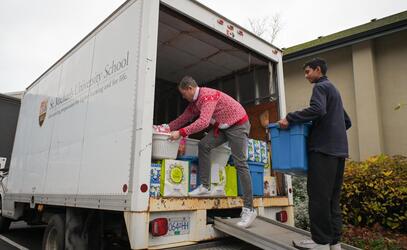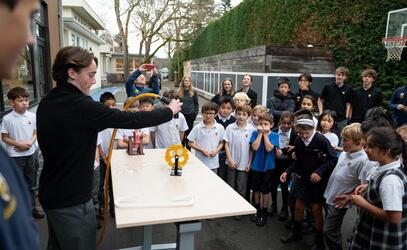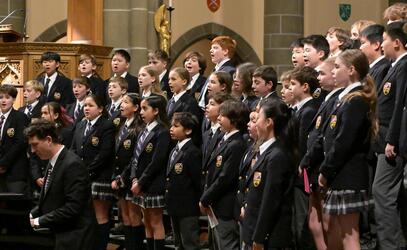Reading together every day is one of the most important gifts we can give our children. In her short and sweet book Read to Your Bunny, Rosemary Wells highlights the importance of reading to “your bunny” so that “your bunny will read to you.” In school, at home, anywhere, any time, children absolutely love listening to, and greatly benefit from, read-alouds. There are countless ways of using the read-aloud to complement and enhance learning, a few of which are shared below. However, in our intense, fast-paced lives, it is the fundamental enjoyment of being together and reading with our children that stands out as paramount.
In the role of teacher-librarian, it is my overall goal to spark curiosity, creativity and passion through a program driven by the joy of reading and the development of literacy of all kinds. At the heart of the library program at our Junior School is honouring and celebrating the essential act of engaging in and with literature: holding a book, turning its pages, reading, making connections, sharing stories, and discussing and expressing new ideas. The simple, yet powerful act of reading aloud has been found to be “the most significant factor in the development of literacy levels of young children.”
Skills Beyond Literacy
Reading and sharing stories with children opens paths of communication, deepens empathy and broadens perspective. I often preface a read-aloud with an explanation and/or story about why I am reading a particular book on a particular day. The books I choose always have a connection to something: to events, people, experiences, to the weather or land, to classroom curriculum, to outdoor education, to traditions and celebrations, to other books, to prior discussions.
During and after a read-aloud, curiosity and connection often drive our conversation. I believe that students can sense and be inspired by a reader’s genuine interest and love for a story, as well as his or her appreciation and excitement for all that can be gleaned. I often ask students questions and tell them what I would like to find out more about. From the reader or teacher, and from within a story, “the modelling of connections, text-to-text, text-to-self and text-to-world, opens the door to students understanding that their knowledge and experiences are essential to comprehension. The more that they are exposed to, even through experiences of others, the more prior knowledge to tap into to make those connections.” Through reading, listening and discourse, students are encouraged and excited to share their own questions, connections and stories; we each contribute and investigate and learn together. Students are empowered as individuals with a voice, and invested collectively as a community of learners.
When reading to your child at home, you can spark meaningful conversations by asking them if the story reminds them of any other stories they have read, or if it connects to an event or person. You can lead by example and say, “This reminds me of...”. You can discuss what the characters are feeling, and how your child would feel or what they would do if they were that character. You can ask them to predict what might happen next! Make up your own new endings or situations! Find out more about related subjects of interest.
Visual Literacy
Picture book read-alouds provide awesome opportunities to explore fine art and visual literacy. The illustrations in books work in conjunction with text (or sometimes stand alone) to tell a story. In a world where images have become a dominant form of information and mode of communication, it is relevant and interesting to discuss the way illustrations are made (the medium, the composition), how they complement and connect with the text, and their meaning and significance. By intentionally looking at and discussing illustrations, students develop a greater ability to “read” images, see relationships between different forms of communication, and derive meaning from a story.
In the library, we often work on a visually based project to enhance and deepen the ideas, connections and understandings. Students always love to creatively express their understanding and ideas, and the read-aloud is a great inspiration and jumping-off point.
At home, you can ask your child what the illustrator used to create the illustrations, and about the style of the art. Can your child think of other books by the same illustrator? How would the story feel if it was illustrated differently? Ask them what part of the story they would most like to illustrate. Ask your child if they can identify feelings, ideas, stories and messages that are being expressed through the illustrations.
Reading Together
Reading with your child develops literacy of all kinds, as well as a myriad of other social, emotional and communication skills. It is also simply a way to enjoy a great story and spend meaningful and sustained time with your child. “When parents read aloud to their children, it provides a valuable opportunity for focused interaction, with reading subsequently situated as a valued social practice.”
Along this journey of literacy, and beginning with the heart of the matter – the read-aloud – your child has infinite opportunities to discover a love of literature and acquire skills above and beyond reading and writing. They gain deeper understandings and broader perspectives, and develop the skills, tools and knowledge to be critical consumers, effective users of information, thoughtful creators and conscientious citizens. The implications and benefits of reading with children are far-reaching and epic, but are as simple as purely enjoying a great story together.
Read to your bunny, and your bunny will read to you!



